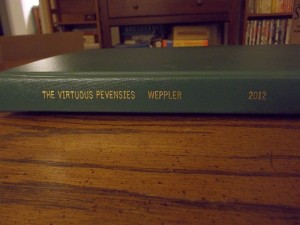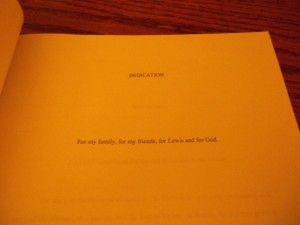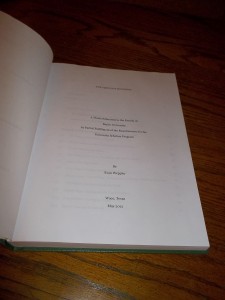I spent about a year and a half working on a thesis to finish my undergraduate studies at Baylor University. Now, that sounds impressive, I’m sure. Truthfully, I did try my best to live a full life while working on this project, and life struggles caused me to start later and take longer than I would have liked. That being said, I learned a lot, not just from my studies, but from the whole experience.
My thesis was on the role of the cardinal virtues in CS Lewis’s The Lion, The Witch, and The Wardrobe, specifically focusing on the Pevensie children: Lucy, Edmund, Susan and Peter.
My thesis was very long, over 160 pages. I often joked that it was a good thesis, but not a good thesis. That is, I believe I make some wonderful points and do a very detailed study of Lewis’s work, but perhaps I don’t do the best job of following all of the rules of an academic thesis.
My main argument is that the four Pevensie children serve as examples of what it looks like to grow in specific virtues. Originally, I planned to write on each of the four, but due to length (it was already 160 pages!) and strength of argument, I focused on Lucy and Edmund.
Lucy is the example of what it looks like to grow in courage. She starts off as a small, quiet child, afraid of the Professor, and she goes from exploring Narnia, to leading her family through the wardrobe, to facing her fears and taking a stand for what is right. She learns from heroes such as Tumnus, Mr Beaver, and Aslan what courage looks like and she eventually becomes known as Queen Lucy the Valiant.
Each of the characters grow in one of the cardinal virtues, and each one is completed by one of the theological virtues. At times, the growth happens simultaneously, but sometimes certain stages have to occur in certain order. Lucy is completed by the virtue of Love, or Charity. She is kind from the beginning, but her understanding of love grows after seeing the heroic self-sacrificial love exemplified by Tumnus, Mr Beaver, and Aslan. Her final transformative act occurs when, upon Aslan’s direction, her love expands from merely caring for an injured Edmund to healing all of the fallen Narnians.
While Lucy grows in courage, Edmund grows in justice. He starts off as a truly grating, selfish character. He is unjust in being disrespectful and antagonistic to elders, unjust in trying to break up the unity and harmony of the Pevensie family, and unjust in his very soul, letting his appetite rule over his other parts. Eventually, however, he is restored and becomes just in every way as he places himself under Aslan’s rule, eventually being known as King Edmund the Just.
Edmund’s growth in Justice happens as he grows in Faith, for the two are intertwined in many ways– Habakkuk 2:4- “the just shall live by faith.” Edmund’s issue is that he doesn’t place faith where he ought– proper leaders like Peter and Aslan– but only in himself, and worse, in the White Witch. He trusts in her, but is betrayed and almost killed; but he is saved by Aslan and he places his full trust in his King, falling into place under Peter’s leadership and eventually destroying the power of the unjust “Queen.”
These first two virtuous Pevensies are very clear; the next two, maybe not as much. Still, I believe a strong case can be made.
I’ll jump ahead to Peter, and you’ll see why in a minute. Peter is the example of growing in prudence. It is importance for him to have prudence, for he is the head of the Pevensie family. Just as reason is to govern the spirit and the appetite in a person’s soul, in Plato’s vision the ruling class were to be guardians led by a love of wisdom, or prudence. Prudence is the practical wisdom one needs to make daily decisions, to choose that which is best. Peter is quick to act, but not always quick to think. Eventually, he is able to act with wisdom and leads the Narnian army to victory. He even becomes known as Peter the Magnificent, magnificent meaning excellent or best.
Peter must grow in Hope before the end of the book. He is naturally an optimistic person, looking for the best in a situation. He must move past basic optimism, however, to a full and certain hope. He is provided with ideas of who he is to become from the Beavers’ stories. He is given a plan of how to win the battle. The crucial moment is when he is given an image of where he will reign by Aslan. Aslan presents it as a fact, not as a possibility. Peter places his Hope in the promised future and the battle is won.
Finally, we come to Susan. Susan is the example of growing in Temperance, though not a perfect example. While many have improper images of Temperance, thinking it merely means abstaining from everything, the best definition of Temperance is finding Moderation or Balance between extremes. CS Lewis defined it as “going the right length and no further.” Susan often wants to withdraw, turn back, stay safe. In an adventure, one cannot have this attitude. Slowly but surely, Susan grows in Temperance, but she becomes known as Queen Susan the Gentle, and even as an adult, she prefers to sit still or turn back than face the next adventure ahead.
Susan, unfortunately, does not return to Narnia at the end of the Narnian series. The others say that she has become absorbed in superficial things like makeup and clothes. When asked about Narnia, she sees them as merely stories. Susan, usually the one longing to stay behind, rushed ahead in life, so eager to become an adult that she threw away all the things of “childhood.” You see, Susan was not completed by a theological virtue because she was not able to grow in any virtue. Too selfish to Love unselfishly, too self-absorbed to have Faith in anyone else, too self-determined to have Hope in anything beyond her understanding, Susan is a curious figure. However, there is still a possibility for Susan to get to Narnia. Lewis, answering a child’s letter, wrote that Susan might someday find her way to Narnia again.
But for Susan to do this, she must be open to Virtue– seeking the Good– and Faith– believing in God. This openness is crucial for Susan, and for any of the characters and for you and for me and for anyone to reach the full life of Faith and Virtue. If we live a closed-off life, dangerously autonomous and self-directed, we cannot be impacted by and find true joy in the Good– and God.
Anyway, that’s one of my major life-creations. Maybe someday I will present it as a book (it probably would do better as a book than as a thesis). But for now, this all I have. Hope you enjoyed the read, and hope you can read The Lion, The Witch, and The Wardrobe in a new light.




